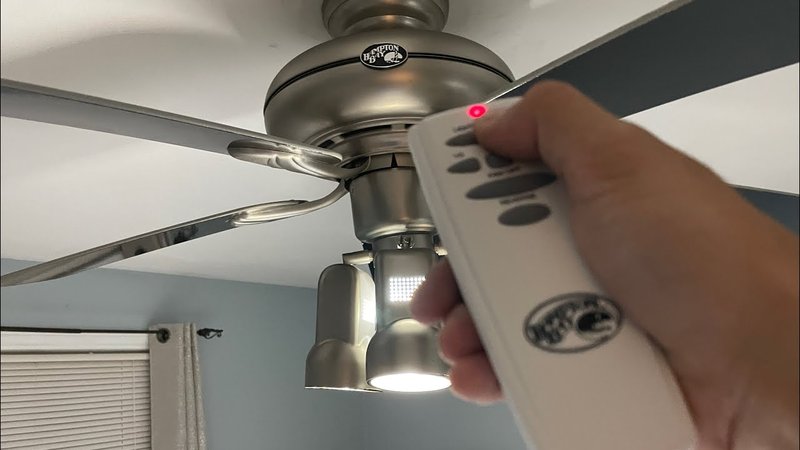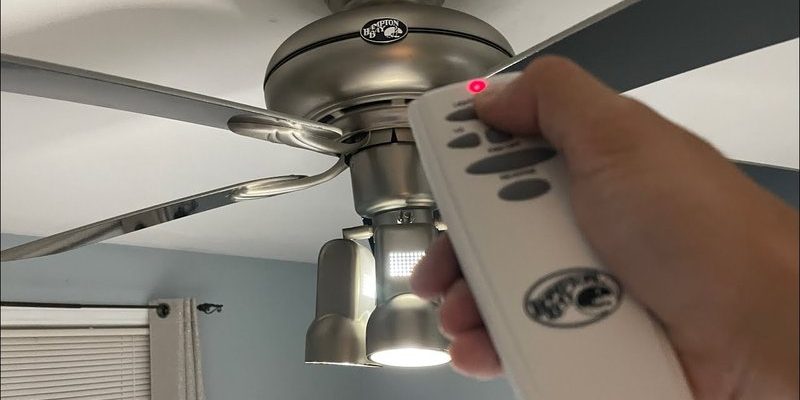
Here’s the thing: remote controls look pretty similar on the outside. Tiny buttons, a battery compartment, and a promise that you’ll never need to pull a cord at 2 a.m. again. But underneath, they use different systems to send codes and signals to the ceiling fan—and that’s where the story gets interesting. Let me walk you through what’s actually happening when you push that ON button, and why using a Hampton Bay remote with a different brand isn’t always simple.
How Hampton Bay Ceiling Fan Remotes Work
Before you mix and match remotes, it helps to know how a Hampton Bay ceiling fan remote actually operates. Picture your remote as a little radio broadcaster; every time you press a button, it sends out a certain signal at a specific radio frequency. Inside the fan itself? There’s a receiver listening for those exact codes—think of it as an exclusive members club. If the code matches, the fan responds. If not, it simply ignores the request.
Hampton Bay typically uses radio frequency (RF) rather than infrared (like most TV remotes). That means you don’t need to point the remote directly at the fan. But even though lots of fans use RF technology, not all of them use the same *code language* or frequency. It’s a bit like sending a postcard in French to someone who only reads Japanese—no matter how polite you are, the message won’t get through.
You might be wondering, what about the dip switches inside the remote or receiver? These tiny switches help pair or sync the remote to your fan by setting a unique code. Both the remote and receiver must have matching dip switch positions, or nothing will work. This is the first hurdle when trying to use a Hampton Bay remote on another fan brand.
Compatibility: Can a Hampton Bay Remote Work With Other Ceiling Fan Brands?
Honestly, I wish the answer here was a simple yes or no. In most cases, a Hampton Bay ceiling fan remote *won’t* work with fans from other brands out of the box. Each brand (Hunter, Harbor Breeze, Westinghouse, etc.) tends to use their own receiver and specific codes. So, pressing the “light” button on your Hampton Bay remote for a Hunter fan usually won’t do anything at all.
There are exceptions, but they’re rare. Sometimes, the actual receiver inside the fan is manufactured by a third party (like Chiin Yee or Rhine Electric Co.), and some receivers are more “generic.” If two different brands happen to use the exact same frequency and the dip switch code matches, then yes, it could work. But this is a bit like winning the lottery—fun to dream about, but don’t count on it.
For most fans, the remote and receiver are a matched pair. Swapping in a Hampton Bay remote usually means you’d have to swap the receiver inside your ceiling fan to a Hampton Bay-compatible unit. This involves getting up on a ladder and dealing with wires—not everyone’s idea of a relaxing afternoon.
Universal Ceiling Fan Remotes vs. Hampton Bay-Built Remotes
You might be wondering about those “universal” ceiling fan remotes sold at big hardware stores. Can they help you control multiple brands, including Hampton Bay? The answer is—sometimes. Universal remotes are designed with wider compatibility, and many include instructions for pairing with various fan models.
Universal ceiling fan remotes come with their own receiver that you install inside your ceiling fan canopy. Once installed, these remotes can often control most major brands. The catch? You’ll have to actually open up the fan and replace the old receiver, which means more than just swapping out the remote handheld device.
If you’re just looking to replace a lost Hampton Bay remote and your fan is an older or different brand, buying a universal kit (remote plus receiver) is usually your best bet. Just *don’t* expect a universal remote to work with your old receiver unless it specifically says so in the directions. Sometimes you’ll see compatibility lists right on the packaging, so read those closely before buying.
Here’s a quick comparison for clarity:
| Remote Type | Works Across Brands? | Requires New Receiver? |
|---|---|---|
| Hampton Bay Remote | Rarely | Yes, if not Hampton Bay fan |
| Universal Remote Kit | Often | Yes (replace receiver) |
| Original Brand Remote | No | No (uses existing receiver) |
Step-by-Step: Testing Compatibility and Pairing a Hampton Bay Remote
Let’s say you’re feeling stubborn and want to try your Hampton Bay remote with another ceiling fan anyway. Here’s how you’d go about testing compatibility:
- First, unplug or shut off the power to your ceiling fan for safety.
- Open both the remote and fan canopy to access the dip switches. These are tiny sliding switches that control the code.
- Match the dip switch positions on both the remote and receiver. If there’s no receiver or the switches don’t match, stop here—compatibility is unlikely.
- Restore power, insert fresh batteries in the remote, and press the buttons one at a time. If the fan responds, you got lucky!
- If nothing happens, compatibility isn’t possible without replacing the receiver.
Most times, you’ll find that the remote does nothing, no matter how you set the dip switches. That’s because the receiver is “listening” for a very specific code and frequency. If your remote speaks a different language, the fan just ignores it. No weird flashes, no error sounds—just nothing at all.
Troubleshooting Common Issues With Ceiling Fan Remotes
If your Hampton Bay remote isn’t working—whether it’s with a Hampton Bay fan or another brand—start simple. The most common problems aren’t about brand compatibility, but everyday stuff:
- Batteries: Old or weak batteries are the
- Code Settings: Double-check the dip switches. Even one switch in the wrong spot means the fan won’t respond.
- Receiver Issues: If the remote can’t connect or control the fan, the receiver inside the fan might be faulty or need resetting.
- Signal Interference: Large appliances, dense walls, or metal objects can interfere with RF signals. Try moving or eliminating obstacles to rule this out.
Sometimes a remote will work only when you’re standing right next to the fan—that’s usually a sign that the receiver or the remote itself is starting to fail. A quick reset (turning power off at the breaker, waiting a minute, and turning it back on) can sometimes help, but if not, you might need a replacement.
If you’re stuck after all this, replacing both the remote and receiver with a universal kit is usually easier and more reliable than troubleshooting obscure brand compatibility.
Alternatives: Using Smart Home Solutions Instead of Brand-Specific Remotes
You might have heard about smart switches or Wi-Fi ceiling fan controllers. These options are getting more popular, and honestly, they can make life easier if you’re frustrated with matching up old-school remotes.
Products like smart wall switches or Wi-Fi modules can work with many ceiling fans—regardless of brand—by *bypassing* the old receiver entirely. You control the fan from your phone, voice assistant, or even routines. For example, a smart switch from Lutron or Leviton can control power to a ceiling fan, and some models handle fan speed as well. They require installation, but the bonus is you aren’t tied to a single remote or worried about losing it.
Just keep in mind: if your fan has features like variable speeds or a dimmable light, check that the smart controller supports them. Not all smart switches play nicely with every feature.
Replacing Your Ceiling Fan Remote: What to Buy and Avoid
When it’s time for a replacement remote, try to match the receiver brand whenever possible. Ordering the original Hampton Bay remote for your Hampton Bay fan is the smoothest solution. If you’re upgrading or need more flexibility (say, you have fans from three brands), universal kits are worth considering.
Here are a few things to avoid:
- Don’t buy a random Hampton Bay remote for a Hunter or Harbor Breeze fan—you’ll likely waste money and time.
- Don’t expect one universal remote to magically fix everything unless you swap out the receivers as well.
- Check for compatibility lists or product manuals before you buy. Google the model number—those PDFs are goldmines for code and pairing info.
If you’re unsure, bring your old remote (or its model number) to a home improvement store. Employees have seen every remote problem under the sun and can usually point you in the right direction.
Final Thoughts: Mixing Ceiling Fan Remotes Is Trickier Than It Looks
At the end of the day, most Hampton Bay ceiling fan remotes are built to work with Hampton Bay receivers—and that’s usually where their magic stops. Trying to use one with a different brand is mostly a dead end unless the hardware inside happens to match or you’re willing to swap out the receiver entirely.
If you want one remote to rule them all, look into universal kits or smart home devices. They might take a little more work to install, but honestly, the peace of mind is worth it—especially if you never want to climb up and re-pair switches again.
If you’re hitting a wall with weird remote issues or just want to simplify your fan setup, a universal approach or smart home upgrade is the way to go. No more hunting for the “right” remote or dealing with silent, unresponsive fans. Sometimes, taking the guesswork out is worth every penny.
